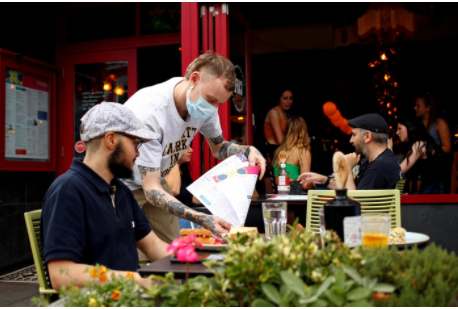Britain’s lacklustre economic growth in August caught out economists that were expecting a much healthier recovery on the back of Rishi Sunak’s much-lauded Eat Out to Help Out campaign.
The dining discount scheme, which saw more than 100 million meals claimed through the government programme, set the government back £522 million. It was designed to encourage the UK population to spend heavily and set the country on track for the perfect V-shaped bounce back, where a recession and subsequent recovery resemble a V-shape on an economic chart.
Instead, gross domestic product grew by a less-than-expected 2.1 per cent in August from July, disappointing analysts that were expecting a 4.6 per cent rise in output and ruling out the V-shaped recovery altogether.
“It appears gains are harder to come by as we stretch further into the recovery, with today’s reading highlighting the lack of a ‘V’ shaped recovery,” said Josh Mahoney, senior market analyst at online trading company IG. “Instead, the best we can hope for is a lopsided, tick-shaped growth trajectory, with the possibility of a second nationwide lockdown highlighting that even such a drawn-out process could be optimistic.”
Economists were optimistic of a straightforward recovery after bumper growth in June of 9.1 per cent, followed by a 6.4 per cent rise in July – a move in the right direction when set against the record contraction of 19.5 per cent in April when the UK was in full lockdown.
Rishi Sunak’s dining discount scheme was then expected to deliver another “impressive month of growth” as residents emerged from their homes to cash in on the government-funded price reduction of 50 per cent on their meal, up to £10 per diner.
The scheme saw a significant rise in the number of people eating at restaurants and cafes, with data from OpenTable showing that restaurant reservations rose by 53 per cent compared with Monday-to-Wednesdays in August 2019, according to the Centre for Economics and Business Research (CEBR).
While the scheme’s success is reflected in the August GDP reading, with output in the accommodation and food services sector growing 71.4 per cent from July, other sectors showed weaker growth. There was only a modest increase in manufacturing output of 0.7 per cent and travel, arts and entertainment dragged down the service sector.
When the ONS released the GDP figures on Friday morning, the UK finance minister was quick to issue a statement on the results, conceding “that many people are worried about the coming winter months”.
Some analysts expect more of a sideways move in the shape of the recovery, with the unwinding of the government’s fiscal support worsening prospects for the next few months.
“We expect the new Covid-19 restrictions to mean that the economy does little more than move sideways in the final three months of the year, leaving economic activity marooned 7.5 per cent short of its pre-crisis level,” said Ruth Gregory, senior UK economist at Capital Economics.
“So while the economy has recouped 64 per cent of the fall in GDP in four months, it may take until late-2022 to get back the remaining 36 per cent. That’s why we think the Bank of England will yet expand Quantitative Easing by a further £250 billion by the end of next year, with the next tranche of £100bn coming this November.”
Looking ahead to the coming quarters, Josie Dent, managing economist at CEBR, expects quarterly growth to slow, falling to just 0.4 per cent in the first quarter of 2021 with output not returning to pre-crisis levels until the mid-2020s.
With the economy “not out of the Covid-quagmire yet”, some analysts say on face-value the rise in August indicates that the fabled ‘V-shaped’ recovery is still on track.
“However, this growth is likely to be reversed in the next quarter with temporary hospitality closures sweeping across Scotland and many parts of England due to rising Covid-19 cases, naturally resulting in waves of redundancies,” said Richard Pearson, director at investment platform EQi.
“With the threat of local lockdowns looming over consumers’ heads and hospitality redundancies on the horizon, consumers aren’t going to dance the night away in the coming months.”



